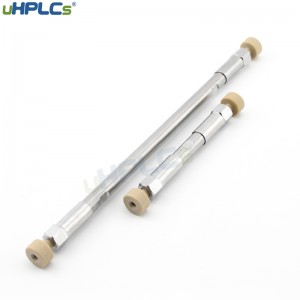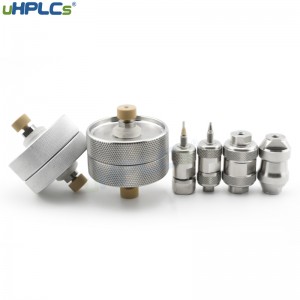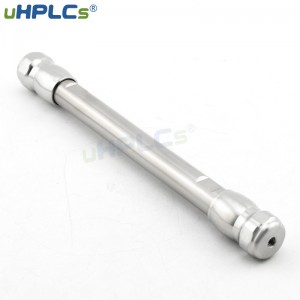Regardless of the interactions being utilized, liquid-phase column chromatography proceeds in six steps.
Column equilibration
Sample loading
Washing
Elution
Washing
Chromatography column regeneration
I. Column Equilibration
Most liquid chromatography protocols begin with a resin equilibration step. A buffer compatible with the target protein and the selected resin is passed through the column. A common practice is equilibrating the column with an equilibration buffer of 5-10 column volumes (CV). For example, binding proteins to hydrophobic interaction resins is most effective at high ionic strengths. Therefore, the resin is equilibrated in a buffer of high ionic strength before sample loading.
It is also essential to consider the properties of the target protein when selecting equilibration buffers, as buffer factors such as ionic strength can be limited by protein stability; typically, one would avoid equilibration buffer conditions that would denature the protein of interest or prevent it from interacting with the stationary phase.
II. Sample loading
After equilibration, the sample is loaded onto the column. The sample is usually loaded in the same composition as the equilibration buffer to maximize the interaction of the protein with the stationary phase.
Samples can be loaded manually or using a sample pump. Some types of chromatography will limit the volume of samples that can be loaded onto the column. Another important loading consideration is the limited ability of most resins to bind proteins. Overloading the column with too much sample can have a detrimental effect on the separation.
Sample overloading affects column efficiency, and contamination of the column affects column efficiency and reduces column life. Installing a protective column in front of the column can protect the analytical column from contamination. The Hundredspectrum Chromatography Protection Column protects all particles, accumulates non-specific adsorbent materials, and will also extend the life of the analytical column used at a slightly alkaline pH.
III. Washing the column
Once the proteins are immobilized in the stationary phase, proteins that interact only weakly or non-specifically with the resin are removed by washing the column with several column volumes of wash buffer. This wash buffer can have the same composition as the equilibration buffer or contain components that disrupt weakly specific interactions.
For example, immobilized metal affinity chromatography (IMAC) uses high concentrations of imidazole to elute proteins bound to the resin. A common practice is to use a wash buffer containing a medium concentration of imidazole to eliminate contaminating proteins that are only weakly bound to the resin. The column is washed until the protein is not detectable in the eluate. When using a chromatography system with a UV detector, wash the column until the 280 nm absorption reading returns to baseline.
IV. Sample elution
After all, non-specific and weakly interacting proteins are eluted from the resin. Proteins that interact strongly with the resin are eluted from the column by changing the buffer composition passing through the resin. In ion exchange chromatography, proteins are eluted with a high ionic strength buffer or by changing the pH to disrupt electrostatic interactions that immobilize the target protein. Conversely, proteins bound to hydrophobic interaction resins are eluted by reducing the ionic strength of the buffer. In affinity chromatography, proteins are typically eluted from the column by introducing competing ligands or cutting the affinity tag. They may be eluted using a high salt buffer or by changing the pH. Other elution schemes may involve mixing solvents of different polarities to adjust the solubility of each component in the mobile phase.
Elution conditions can vary in a linear gradient or stepwise fashion. Typically, a gradient elution scheme (in which the mobile phase composition varies linearly with time) is chosen to determine the elution profile and the concentration of elution buffer that will allow the protein of interest to be released from the resin. Once that concentration is determined, to save time, a stepwise isocratic elution scheme can be designed in which the composition of the mobile phase is constant at each step and can be designed for future purification.
Note: Size exclusion chromatography does not require buffer changes because it does not depend on specific interactions between the mobile and stationary phases. There is no proper wash and elution step, as SEC relies only on porous beads delaying large molecules while small molecules pass through the resin with minimal resin interactions.
V. Washing
After the target proteins are eluted from the resin, any proteins bound to the resin are eluted by increasing the strength of the elution buffer. This step allows the column to be repeated for future separations.
VI. Column Regeneration
After stripping the remaining compounds bound to the medium, the column is either saturated with equilibration buffer for subsequent reuse or filled with storage buffer.
Post time: Aug-11-2022









